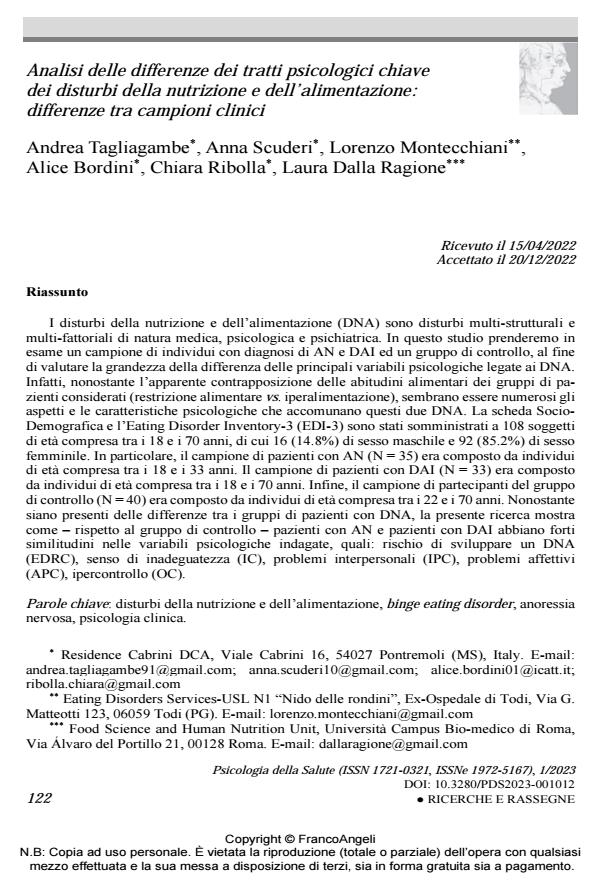Analisi delle differenze dei tratti psicologici chiave dei disturbi della nutrizione e dell’alimentazione: differenze tra campioni clinici
Titolo Rivista PSICOLOGIA DELLA SALUTE
Autori/Curatori Andrea Tagliagambe, Anna Scuderi, Lorenzo Montecchiani, Alice Bordini, Chiara Ribolla, Laura Dalla Ragione
Anno di pubblicazione 2023 Fascicolo 2023/1
Lingua Italiano Numero pagine 17 P. 122-138 Dimensione file 256 KB
DOI 10.3280/PDS2023-001012
Il DOI è il codice a barre della proprietà intellettuale: per saperne di più
clicca qui
Qui sotto puoi vedere in anteprima la prima pagina di questo articolo.
Se questo articolo ti interessa, lo puoi acquistare (e scaricare in formato pdf) seguendo le facili indicazioni per acquistare il download credit. Acquista Download Credits per scaricare questo Articolo in formato PDF

FrancoAngeli è membro della Publishers International Linking Association, Inc (PILA)associazione indipendente e non profit per facilitare (attraverso i servizi tecnologici implementati da CrossRef.org) l’accesso degli studiosi ai contenuti digitali nelle pubblicazioni professionali e scientifiche
I disturbi della nutrizione e dell’alimentazione (DNA) sono disturbi multi-strutturali e mul-ti-fattoriali di natura medica, psicologica e psichiatrica. In questo studio prenderemo in esame un campione di individui con diagnosi di AN e DAI ed un gruppo di controllo, al fine di valutare la grandezza della differenza delle principali variabili psicologiche legate ai DNA. Infatti, nonostante l’apparente contrapposizione delle abitudini alimentari dei gruppi di pazienti consi-derati (restrizione alimentare vs. iperalimentazione), sembrano essere numerosi gli aspetti e le caratteristiche psicologiche che accomunano questi due DNA. La scheda Socio-Demografica e l’Eating Disorder Inventory-3 (EDI-3) sono stati somministrati a 108 soggetti di età compresa tra i 18 e i 70 anni, di cui 16 (14.8%) di sesso maschile e 92 (85.2%) di sesso femminile. In particolare, il campione di pazienti con AN (N = 35) era composto da individui di età compre-sa tra i 18 e i 33 anni. Il campione di pazienti con DAI (N = 33) era composto da individui di età compresa tra i 18 e i 70 anni. Infine, il campione di partecipanti del gruppo di controllo (N = 40) era composto da individui di età compresa tra i 22 e i 70 anni. Nonostante siano presenti delle differenze tra i gruppi di pazienti con DNA, la presente ricerca mostra come - rispetto al gruppo di controllo - pazienti con AN e pazienti con DAI abbiano forti similitudini nelle va-riabili psicologiche indagate, quali: rischio di sviluppare un DNA (EDRC), senso di inadegua-tezza (IC), problemi interpersonali (IPC), problemi affettivi (APC), ipercontrollo (OC).
Parole chiave:disturbi della nutrizione e dell’alimentazione, binge eating disorder, anoressia nervosa, psicologia clinica
Andrea Tagliagambe, Anna Scuderi, Lorenzo Montecchiani, Alice Bordini, Chiara Ribolla, Laura Dalla Ragione, Analisi delle differenze dei tratti psicologici chiave dei disturbi della nutrizione e dell’alimentazione: differenze tra campioni clinici in "PSICOLOGIA DELLA SALUTE" 1/2023, pp 122-138, DOI: 10.3280/PDS2023-001012